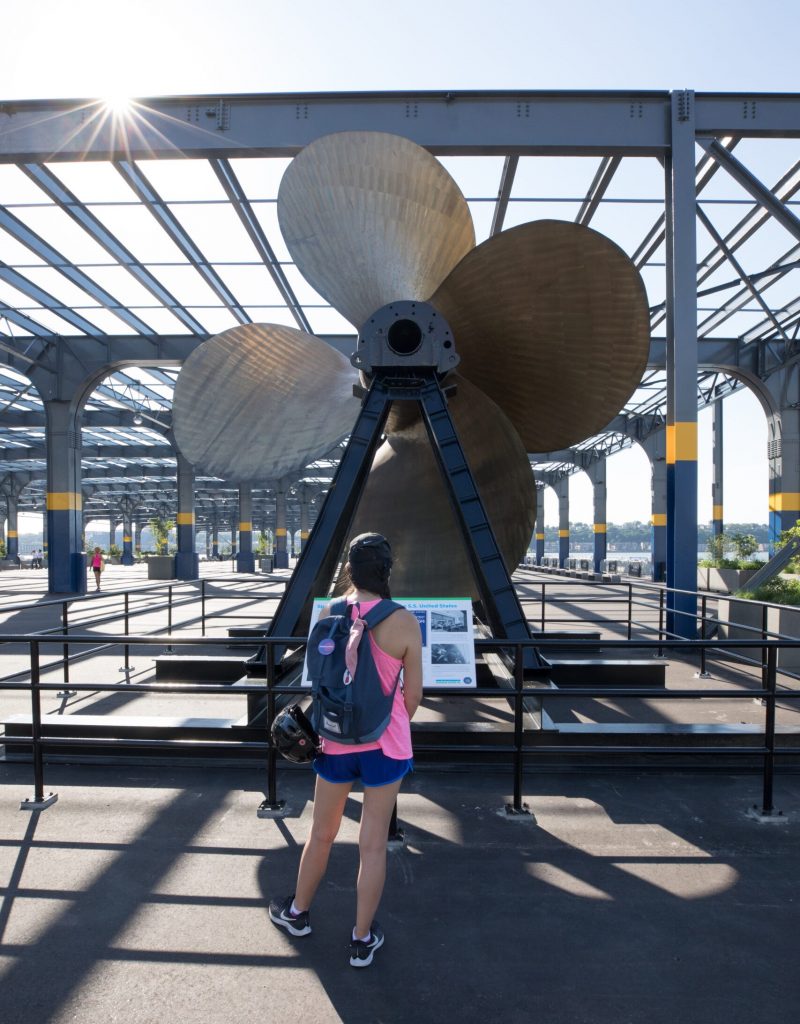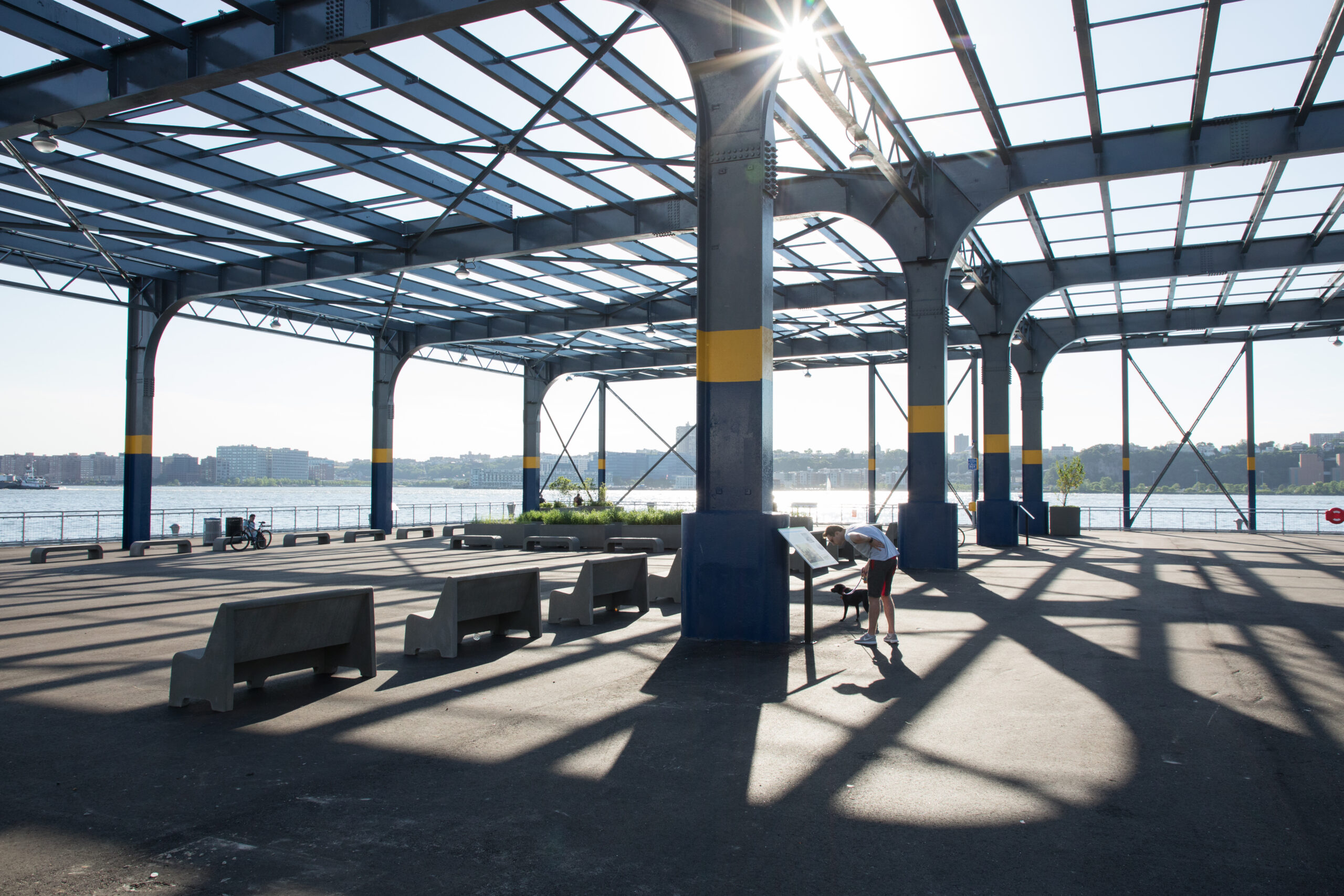BY LINCOLN ANDERSON | The governor has signed legislation by state Senator Brad Hoylman-Sigal and Assemblymember Tony Simone to amend the Hudson River Park Act to allow redevelopment of Pier 76 with at least 50 percent parkland, plus “create a process” to kick the W. 30th Street helipad out of the park.
“We’re elated that Governor Hochul signed our legislation to develop new open space and commercial uses on Pier 76 in Hudson River Park and create a community-led process to facilitate, once and for all, moving the W. 30th Street helipad off of the parkland,” Hoylman-Sigal and Simone said in a joint statement.
The bill (S.9408C/A10224C) modifies the Hudson River Park Act to create a structure for a request for proposals, or R.F.P., to provide revenue to complete construction of Hudson River Park, new green space on the West Side and “a path forward” to free up parkland that the helipad has occupied for decades.
“The new vision of Pier 76 is one of a green space for the entire community to enjoy, while simultaneously providing the revenue needed to bring the pier to the beautiful standard that New York City is accustomed to,” the two West Side lawmakers said.
The bill also notes that Pier 76, located at 36th Street, needs $150 million in repairs.
The legislative tweaking of the park act was supported by Community Board 4 and the Pier 76 Task Force.
However, longtime Hudson River Park activist Tom Fox was not impressed by the news — more like livid. Fox was the president of the Hudson River Park Conservancy, the Hudson River Park Trust’s predecessor agency, which completed the final plan for the now 26-year-old park. He recently published a book recounting the history of the waterfront park’s creation.
In short, Fox feels Pier 76, formerly home to a New York Police Department tow pound, should be 100 percent recreational without any commercial development. Instead of requiring the park to be self-funding via designated commercial “nodes” on certain piers, like Pier 76, Fox would like to see the properties in the “inboard” area — the blocks to the east of the West Side Highway — help fund the park. To that effect, he has long advocated for a so-called Park Improvement District that would raise funds for the park from adjacent properties by means of an annual contribution to a special assessment district, as is done for Bryant Park and Union Square Park.
“We have 26 million square feet of prime development going on across the street — Hudson Yards,” he stressed. “Hudson Yards puts nothing into the park — and they’re literally right across the street.”
Meanwhile, C.B. 4, which includes Chelsea and Hell’s Kitchen, is among the most park-starved districts in the entire city.

In fact, Pier 76 wasn’t yet part of the park at the time of the founding park act of 1998 — although the hope then was that it eventually would be once the city relinquished control of it. The idea, as stated in the park act, was always that the pier would eventually be 50 percent recreational. It wasn’t until a few years ago, though, that former Governor Andrew Cuomo finally was able to boot out the entrenched Police Department tow pound, allowing the pier to be incorporated into the park.
In sync with the governmental view of Pier 76 over the years, Hoylman-Sigal and Simone’s modification mandates that “at least 50 percent” of the pier be recreational, with the rest available for commercial development. Yet, the height limit their bill sets for the Hudson River site’s commercial component is a staggering 185 feet, or around 18 stories — which is simply shocking to Fox.
“It’s terrible,” he declared.
That height was actually hashed out two years ago by the Pier 76 Task Force, which was led by Carl Weisbrod, a senior adviser at HR&A planners and the city’s former head of economic development. However, Fox said, C.B. 4, for one, was presented with no other options than this scenario.
“There’s nothing that says it has to be [commercially] developed — except that fakakta legislation,” Fox fumed. “It’s just an ill-advised move. They’ve been played, I believe.
“I think it’s great that the governor is moving forward with something,” he said. “It’s sad that they’re selling their left arm to save their right.
“This goes back to the 1990s, when there was a rail yard there,” Fox noted of the 50/50 scheme for the prime pier. “Now Hudson Yards is here, the tow pound is vacated — there’s no reason to develop half of the pier commercially.”
Uses not allowed at Pier 76 include residential, hotels, commercial office (unless connected to a permitted use), casino and riverboat gambling
Also, in shades of The Little Island at W. 14th Street, which replaced the run-down, traditionally linear Pier 54, the legislative change also allows the footprint configuration of Pier 76 — though not its size — to be altered.
Nor was the veteran park activist pleased at the idea of “a process” to get the noisy and polluting helipad out of the park, noting that efforts to do so have been ongoing for decades.
“The ‘process’ hasn’t panned out for the past 25 years, so what makes you think it will this time?” he scoffed.
In addition, in other Hudson River Park News, the Park Trust recently announced that it will be spending $65 million to build the park’s mostly unfinished section from 29th Street to 46th Streets — basically from the heliport to the Intrepid Museum. Much of this stretch is simply unadorned asphalt pavement — and, to Fox’s chagrin, even includes New York Waterway ferry shuttle buses (with New Jersey license plates to boot) parking there overnight.
Again, though, Fox thinks there is a better way things could be done — namely, by bundling the Pier 76 redevelopment in with this $65 million project.
“Why wouldn’t they be doing these things together?” he asked. “It’s divide and conquer.”


Parks add value just for making nature accessible. Should we develop half of Central Park to pay for it?
Making the space 100% park would add more value than it cost if all it did was result in closing the heliport.
They should do a vertical aquaponic farm as part of the commercial use.
It’s outrageously expensive to maintain waterfront infrastructure. The money has to come from somewhere.
I wholeheartedly agree. That doesn’t mean we should sell the park to commercial developers to save it.
In addition to public funding and private philanthropy, some funding should come from those who benefit the most from the public investment creating the park.
They will definitely be impacted the most if the park falls into disrepair as parks like Bryant Park and Union Square did in the 1980s for lack of funding.
There is currently an abundance of commercial retail and office space in Manhattan; there is no need for sacrificing prime, water-adjacent real estate for endeavors not dependent on any need for waterway adjacency or access. Even if there was a dearth of such available space in Manhattan, the primary uses of space in Hudson River Park (“HRP”) should be for the leisure, recreation and personal enjoyment of New Yorkers and tourists.
The original community members and politicians who conceived and expedited HRP were visionaries. “All boats rose” when HRP was built, including the surrounding real estate owners whose property values increased as a result.
As HRP requires funding for operations and infrastructure, it should be sourced from public funds, a levy on those adjacent to HRP who have reaped the benefits without the cost, and from private benefactors (for which New York is not lacking). We must be more resourceful and creative than to sacrifice recreational space for office space (it is bad enough that Pier 57 has been substantially sacrificed for office space).
Senator Hoylman-Sigal prioritized real estate developers over the citizenry that elected him and failed miserably in his charge. I would be more impressed if he could lead an effort to shore up (pun intended) HRP’s funding than to take the easy way out of “selling out” to real estate concerns.
New York IS New York because of its waterways and access to it; all continuing and remaining uses of HRP property should be devoted to educational, recreational, conservational and spiritual uses that have ties to the waterway.
Living is New York is “tough enough,” as we all know; our saving grace, our “oasis” is park access; we need more park space, not less of it. And creating new park space is a formidable task; let us not forfeit what we already have.
These are the moments when I long for the famous/infamous Robert Moses, who prioritized park space and always managed to arrange its financing through public means. Even Robert Moses would (rightly) have opposed Senator Brad Hoylman-Sigal and his current efforts.